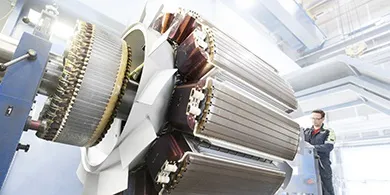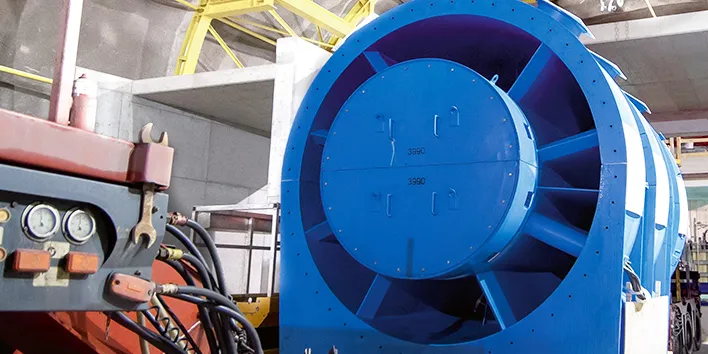Synchronous Drives
The versatile and compact synchronous drive system is a combination of a high-efficiency motor, drive computer with integrated power module (IPM), power input circuit and control electronics required for operation.
What we Do
Control of Synchronous Motor Drives

Synchronous motors are structurally similar to brushless DC motors, but their coils are driven by polyphase AC current. This allows them to produce a more stable output torque. Three or more phases are typically used for motor excitation, and the more phases used, the more complex the control circuit.

The main advantages of self-controlled synchronous motor drives are their fast response and dynamic capabilities. They avoid the inherent coupling effects of DC motors and can also handle variable loads. To achieve this level of performance, self-controlling synchronous motor drives require fast computational processors and DSPs. These drives are also commonly referred to as AC5 motor drives.

The speed of the rotor of a synchronous motor depends on the phase difference between its rotor and stator. When this difference is small, the torque produced by the rotor is low. As the phase difference increases, the torque produced by the motor increases. Maximum torque is produced when the phase difference reaches 90 degrees. Therefore, it is essential to control the peak value of the input current to achieve the required torque. Vector control is another method of controlling the torque of a synchronous motor.
How a synchronous motor works
The working principle of a synchronous motor is very simple: as the load on the motor increases, the rotor slips back relative to the stator. This results in an increase in torque, and as a result, the voltage on the rotor increases. An increase in voltage increases the current drawn from the power supply. Therefore, a synchronous motor is able to provide increased mechanical loads without reducing its speed.
To understand how a synchronous motor works, consider connecting the stator windings to a three-phase AC source. This current creates a magnetic field that rotates at 120 f/p revolutions per minute. Additionally, the rotor armature contains an additional field circuit, the magneto. This aligns the magnetic field with the rotor speed.
When the rotor and stator are aligned, the poles of the rotor become entangled, creating a magnetic field. This forces the rotor and stator to rotate at the same speed. This is called sync speed. The synchronous speed of the motor will be equal to the torque produced by the load.
Get Started
Starting of Synchronous Motor
Synchronous motors do not have self-starting capabilities, and the excitation method of their stators is similar to that of induction motors. However, when DC power is supplied to the rotor, the rotor is excited differently. When three-phase AC power is supplied to the stator, this creates a rotating magnetic flux, allowing rotation at synchronous speed. When DC power is supplied to the rotor, the rotation of the magnetic field will take place at a synchronous speed due to the generated magnetic flux, in this case the rotor behaves as a magnet with two salient poles.
When the rotor is stationary, it does not follow the synchronous rotation of the magnetic field. In this case, the rotor is fixed in its position due to the rapid movement of the poles, so it can be said that the synchronous motor is not self-starting.
About Us
Pull in of Synchronous Motors
When the synchronous motor’s rotor reaches close to synchronous speed, the DC excitation power is turned on, and the traction process begins. Due to various disturbances in the motor due to the phase angle and torque angle during the switching on of the DC power supply, and also multiple air gap pole slips occur. As the pull-in process is complete, the rotors gain synchronous speed. The DC power supply should be switched on as soon as possible at the most favorable angle. Just like when a synchronous motor is running as an induction motor, when the induction motor is at its highest speed, the DC source should be powered, which will be the best moment as the speed difference will be minimal.
Construction of Synchronous Motor
The stator and rotor are the two main parts of a synchronous motor. The stator is stationary and it carries the armature windings of the motor. The armature winding is the main winding of the induced electromotive force in the motor. The rotor carries the field windings. The main magnetic field flux is induced in the rotor. There are two designs of rotors, namely salient-pole rotors and non-salient-pole rotors.
Synchronous motors use salient pole rotors. Embossed means that the poles of the rotor protrude towards the armature windings. The rotor of a synchronous motor is made of sheet steel. The laminations reduce the eddy current losses that occur in the transformer windings. Salient pole rotors are mostly used in the design of medium and low speed motors. To obtain high speed cylindrical rotors are used in motors.
Braking of Synchronous Motors
As we all know, braking is divided into three types: regenerative braking, dynamic braking, and plug-in braking. But for synchronous motor drives, although pluggable can theoretically be applied, only dynamic braking can be applied. Regenerative braking cannot be applied to them because they require a higher speed than synchronous speed. Dynamic braking is done by disconnecting the motor from the mains and connecting it to a three-phase resistor. At that time the motor works as a synchronous generator and the energy is dissipated in the resistor. Synchronous motors do not use plugging because high plugging currents can cause severe interference and line damage.
Join Us
Synchronous Motors and Drives
Various types of synchronous machines are analyzed in the context of low (medium) power drives, with reference to the given performance in terms of efficiency. Mainly, we consider field motors with reference to using rare earth and ferrite magnets for different types of motor structures. Their performance compared to that of induction motors also depends on frame size. Furthermore, this comparison extends to synchronous reluctance machines as an emerging solution in this field. Finally, some application considerations are given in order to find the best solution for each domain.
What is a Synchronizer?
A synchronous motor is an AC motor that runs synchronously with the supply current. Its rotation period is an integer number of alternating cycles. This type of machine has high efficiency and is used in various applications. Its main advantage is that it is very quiet. This type of machine is often used in power plants. Synchronous motors have two windings. Each winding generates a constant voltage and is connected to a DC voltage source. This DC power is then applied to the field windings of the synchronous machine. When the rotor falls below synchronous speed, the rotor’s magnetic field reverses, driving the particles around the hysteresis loop. This process produces torque. Synchronous motors can produce high starting torque with low ripple. They are also very quiet. A common disadvantage of synchronous motors is that they are limited to small power ratings.
Accounting Resources & Articles
China Good quality Typ Series Variable Frequency Permanent Magnet Synchronous AC Electric Motor 11kw with Best Sales
Product Description product/uZeaIHzKEckV/China-Ye3-Series-Super-Efficiency-Three-Phase-Asynchronous-Motors.html Xihu (West Lake) Dis. Xihu (West Lake) Dis.i Motor Co.,Ltd which was founded in 1969, is national appointed as chief factory for small and medium-size...
China Best Sales 64mm 24V 220V Permanent Magnet AC Synchronous Gear Electric Motor supplier
Product Description I. CH MOTOR - AC Re-synchronous Motor S643(64MM) Specifications: -Output Speed: 15-152RPM -Voltage: 24-220VAC -Current: 0.1-0.9A -Frequency: 50/60Hz -Input Power: <20W -Noise: <45dB -Rotation: CW/CCW Bi-directional Drawing: Specification: ...
Main Features of Synchronous Motor
Following are the characteristic features of a synchronous motor −
- A synchronous motor either runs at synchronous speed or not at all, i.e., while running, it maintains a constant speed from no-load to full load.
- The speed of a synchronous motor is independent of load.
- Synchronous motors are not inherently self-starting. Some auxiliary means have to be provided for starting.
- A synchronous motor will stall if, while running, the load on the shaft is increased beyond the maximum limit that the machine can drive.
- A synchronous motor can be made to operate under wide range of power factor both lagging and leading.
Contact Us
Place an order, discuss your custom parts needs, or just ask us a question. We have professionals to answer your emails.